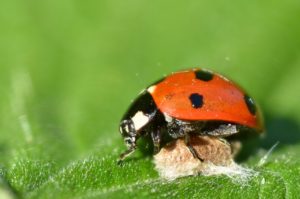

The parasitoid wasp D. coccinellae lays its eggs inside a ladybeetle. After 20 days of larval development, a prepupa emerges from the ladybeetle and fabricates a cocoon between the beetle’s legs. At the same time, the ladybeetle becomes paralyzed. It remains on top of the cocoon (pictured; image credit), protecting it until an adult wasp emerges. Remarkably, some ladybeetles then resume their normal lives!
Given what we know about how parasitoid viruses can alter the manipulation of their hosts, it was only logical to search for a virus that paralyzes the ladybeetle. Sequencing of RNA from the heads of parasitized ladybeetles revealed the presence of an RNA virus which the authors call D. coccinellae paralysis virus, DcPV. The virus is a new member of a Iflaviruses, a family of picornavirus-like, (+) strand RNA viruses that infect insects. DcPV was found in wasps in Poland, Japan, and The Netherlands, confirming its cosmopolitain nature.
Viral particles were observed in cells lining the wasp oviducts, but not in the lumen. Viral genomes were undetectable in wasp eggs, became more abundant during hatching, and ceased to replicate in adult wasps. The levels of virus in the ladybeetle abdomen and head increase with time to egress, suggesting that it was transmitted from the wasp larvae to the host. In ladybeetles where the wasp egg did not develop, viral replication does not occur.
DcPV appears to be neurotropic. Before larval egression, no changes were observed in the nervous system of the ladybeetle, but glial cells were full of virus particles. After egression, vaculoles developed in glial cells and neurons degenerated. This damage was less severe in beetles that survived and recovered from paralysis. An expansion of glial cells in these hosts might explain how normal brain functions were restored.
Insects respond to infection with an RNA-based antiviral response. Components of the RNA based immune system were down-regulated during larval development, possibly by viral proteins, allowing virus to invade the nervous system. Resumption of the antiviral reponse might enable recovery of the ladybeetle after emergence of the wasp.
It appears that DcPV is a wasp symbiont that manipulates the behavior of the ladybeetle host to ensure development of wasp offspring. This hypothesis can be tested by removing DcPV from infected wasps, or by adding DCpV to uninfected hosts, and determining the effect on larval development.
We now realize that animals are actually holobionts: an aggregate of eukaryotes, bacteria, and viruses. Therefore host-parasite interactions are really holobiont-holobiont interactions.

Pingback: Bodyguard manipulation by a virus - VETMEDICS
Pingback: Bodyguard manipulation by a virus - Virology